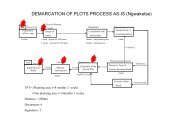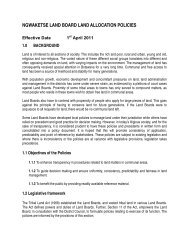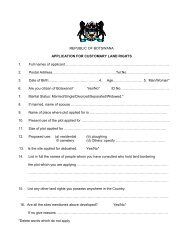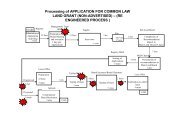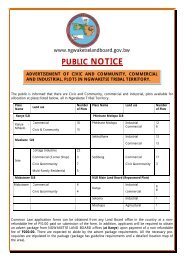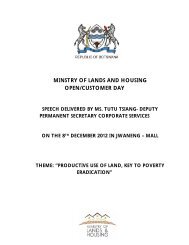District Intergrated Land Use Plan - Ngwaketse Land Board
District Intergrated Land Use Plan - Ngwaketse Land Board
District Intergrated Land Use Plan - Ngwaketse Land Board
Create successful ePaper yourself
Turn your PDF publications into a flip-book with our unique Google optimized e-Paper software.
CHAPTER 3<br />
PHYSICAL ENVIRONMENT AND ITS COMPONENT SYSTEM OF RESOURCES<br />
are medium textured sandy clay loams, clay loams, silty clay loams and silt becoming fine<br />
textured clays, silty and sandy clays in Barolong Farms. The soils have no pH and sodium<br />
limitations and low CEC values are moderately fertile.<br />
3.4.5 There are five types of Luvisols in the <strong>District</strong> namely; Calcic Luvisols, Chromic Luvisols,<br />
Ferric Luvisols, Gleyic Luvisols and Haplic Luvisols. They occur in the southern part of the<br />
<strong>District</strong> as a thin belt from Pitsane through Good Hope and northwards to around<br />
Mmathethe, south of Kanye, Maokane, through Jwaneng and east of Jwaneng.<br />
3.4.6 South of Kanye, and in Maokane Luvisols soils are flat with a slope of less than 0,5 percent,<br />
almost flat around Jwaneng and undulating north of Barolong Farms and south of<br />
Mmathethe. Luvisols are moderately deep between 50cm and 100cm in the southern part<br />
of the hardveld becoming deep (100cm-150cm) in the sandveld. Calcic Luvisols in<br />
Maokane are well- drained coarse sands, sandy loams and loamy sands while in the<br />
southern part of the hardveld they are imperfectly well-drained fine textured clays, silty and<br />
sandy clays. Southeast of Jwaneng the soils are moderately well-drained medium textured<br />
sandy clay loams, clay loams, silty clay loams and silt. Chromic Luvisols in the Metlobo<br />
area are moderately well- drained medium textured sandy clay loams, silty clays and sandy<br />
clay in the hardveld tongue. Luvisols on the hardveld tongue have a low pH (5.4-5,5) while<br />
to the southeast and east of Jwaneng they have a high pH (7,51-8,3) in addition to sodium<br />
limitations. South of Kanye, in Maokane, east of Mmathethe and north of Barolong Farms<br />
Luvisols have no pH and sodium limitations. The soils have a low CEC value (5,1-10 Meq/<br />
100gr) in Maokane and Barolong Farms while around Metlobo, the hardveld tongue and<br />
east of Jwaneng the have higher CEC values (10,1- 20Meq/100gr). Luvisols ranges from<br />
fertile to very fertile.<br />
3.4.7 Regosols occur as Calcaric and Eutric Regosols which are associated with the hardveld<br />
tongue, are found in the northern part of Kanye and to the north, northwest and southwest<br />
of Kanye They are found to the west of Mmathethe and northeast of Good Hope along the<br />
boundary with South East <strong>District</strong>. They are associated with hilly terrain in Kanye and the<br />
northwest of Kanye. Regosols range from very shallow depths of less than 25cm to<br />
moderate depths of between 50cm and 100cm. Regosols occur mostly as coarse textured<br />
sands, sandy loams and loamy sands. While Regosols generally have no sodium limitations<br />
and few pH limitations, these soils have pH limitations around Kanye, Sedibeng and<br />
northeast of Good Hope. They range from moderately well-drained and well-drained in the<br />
south to somewhat excessively drained in Kanye and northeast of Kanye. Regosols have<br />
moderate to low fertility soils.<br />
3.4.8 Haplic Acrisols cover about 558km 2 in the gently undulating eastern part of the <strong>District</strong> from<br />
south east of Kanye to Digawana. The soils are moderately well-drained to well drained fine<br />
textured clays, silty and sandy clays; medium textured sandy clay loams, clay loams, silty<br />
clay loams and coarse textured sands, sandy loams and loamy sands. The soils are<br />
moderately deep with a depth range of between 50cm and 100cm. Haplic Acrisols generally<br />
have no sodium and pH limitations save in isolated areas with high and low pH values.<br />
Exchangeable Cation Capacity (CEC) ranges from a low of less than 5 to 20Meg/100gr.<br />
They are moderately fertile soils.<br />
3.4.9 Calcisols are less extensive covering only a small area and occur in the southern part of the<br />
hardveld tongue and the sandveld are flat to gently undulating well drained to moderately<br />
well drained coarse textured sands, sandy loams and loamy sands. The soils range from<br />
moderately deep to deep with depths of 50-100cm and 100-150cm respectively. Along the<br />
fossil valley in the sandveld, the soils have no pH and sodium limitation with the exception<br />
of the soil in the hardveld. Exchangeable Cation Capacity of between 5 and 10Meg/100gr.<br />
36 REPORT OF SURVEY



